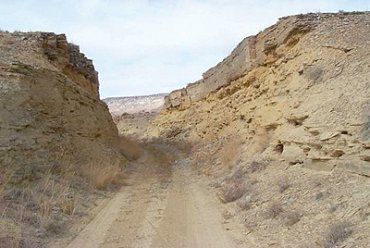Bryan Torgerson presented a team from SITLA at the recent public lands meeting. They have been working on developing an interpretive site at the old spirit railroad grade on the Swell. They proposed to put up kiosks to tell the history of the site.
They have been involved in a number of these types of projects throughout the state and view the railroad grade as worth preserving. They want to partner with Emery County on the project. After the project is complete they would like Emery County to keep an eye on it and maintain it. They will partner with a variety of other agencies on the project as well.
There are dugouts in the area as well as the grade itself. This site was damaged by some mining in the area. The grade was worked on during the 1880s but then the route for the railroad was moved and the grade abandoned.
SITLA has some of the history of the site on its website. They will add a buck and rail fence to the area and some interpretive kiosks. The kiosk will explain the purpose of trustlands and the history of the site.
Ed Geary, council member said at one time there were signs in that area, but they aren’t there any more. There are also boulders with historic inscriptions in the area. It was suggested SITLA have a map at the kiosk to direct people to other sites of interest in the area.
Sherrel Ward also suggested there could be informational pamphlets at the kiosk with more information.
SITLA would like to work on this project in 2016.
The Denver and Rio Grande Railroad began extending its narrow-gauge line through the northern portion of the San Rafael Swell. From Green River the railroad would travel through Cottonwood Wash, and Buckhorn Flat to the Castle Valley Junction, located east of Huntington.
At the junction the railroad would divide with one branch going south, and eventually go through Salina Canyon. The other branch would head north through Price Canyon. During construction railroad ties were cut in Tie Fork Canyon, a canyon that splits from the main Huntington Canyon. Once the ties were cut they were floated down the Huntington Creek for 20 miles and then fished out of the creek for delivery to the railroad. The railorad tie business only lasted for about a year once the railroad was abandoned.
The railroad through Price Canyon was completed but this leg of the railroad through Emery County was never built.
Interpretive Site to be created at Old Spirit railroad grade

"The railroad grade cut through the hill."
